The city of Skopje is not defined by its buildings or other facilities. This city is defined by its inhabitants, by their family ties, work relations, their knowledge and actions. It is not made up of the past, but of the present which is continuously being created by the people living in it. Public spaces in the city, such as squares, parks, streets and bridges, which belong to all the citizens, should reflect that fact. [...] Let’s make this city truly ours.1
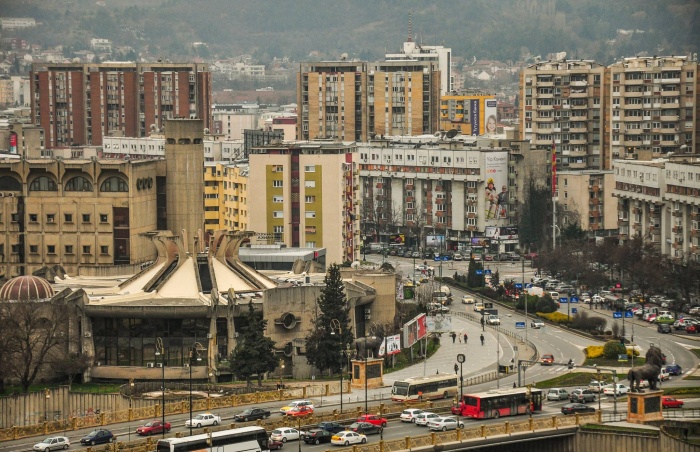
Budynek Poczty Głównej w Skopje, przykład architektury brutalistycznej. Zdjęcie: Marija Grujovska. Dzięki uprzejmości artystki.
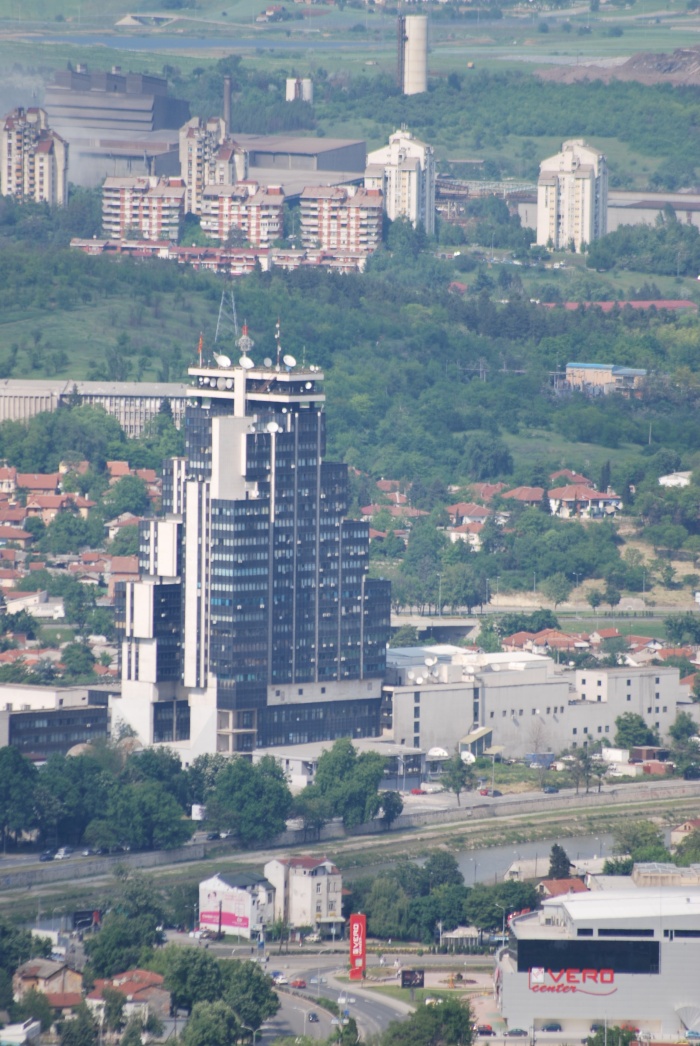
Centrum MRT, budynek telewizji i radia. Do 2015 roku najwyższy budynek w Skopje. Zdjęcie: Raso, 2011. Źródło: Wikimedia Commons
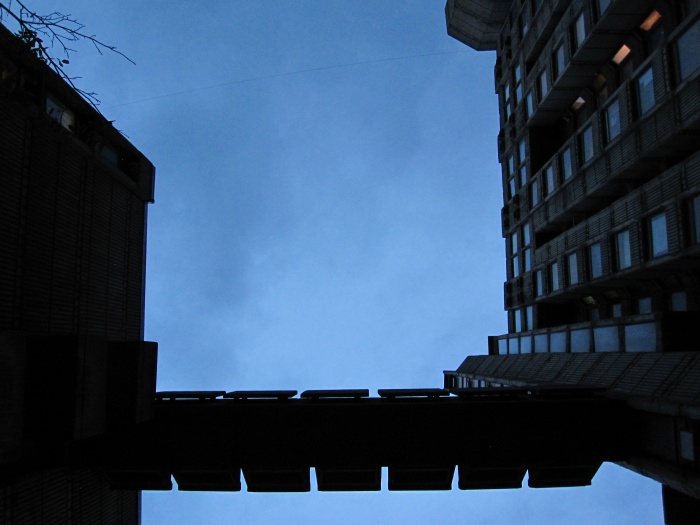
Akademik "Goce Delcev" w Skopje, przykład architektury brutalistycznej. Zdjęcie: Tashkoskim, 2013. Źródło: Wikimedia Commons
Summer 2015 − an unlikely occurrence shocked the citizens of Skopje the capital of Macedonia. Videos and pictures appeared of a few sharks swimming in the River Vardar in Skopje. “We went totally insane!”, “This is not normal!”, and “Best thing that has appeared in Skopje!” are only a few of the comments on the YouTube video with 263,759 views. The sharks became a one-day sensation, when people were not sure what was really happening. After all, in that same river, the building of a galley had just been completed. A galley-restaurant that is. With its depth of around 4 meters, galleys have never sailed through that river. It seemed like the building madness in the capital city of Macedonia went so far, that even sharks swimming in the river was not something unbelievable. However, what later appeared to be the case is that an anonymous artistic group had installed the “sharks” in the river. This artistic action was one of many that took place around the center of Skopje. These actions are only a minor part of the bigger picture, but they do serve as a good illustration of this type of “out-of-the-box” activism in the city. Whether engaged in preserving cultural heritage, fighting to save a park, or addressing doubtful public policies; activists in Skopje have been working extensively and constantly. Urban mobilization in the city has been on a constant rise since (roughly speaking) 2010. These actions in the city space not only speak of the need for independent spaces, culture hubs, and green areas. Rather, they speak of wider political, social, and economic circumstances that have triggered them. In order to delve deeper into the case of urban mobilizations in Skopje a careful look into the factors that triggered them is needed. An overview of the transformations and reconstructions that occurred in its modern history will be provided as the needed context for understanding the current state of affairs in the city.
1. A City in Clouds – A Brief Historical Overview of the Urban Development of Skopje
Throughout its historical development, Skopje has had the “ability” to attract many unfortunate events which have reshaped its progress, look, urbanization, and identity. The city dates from the times of the Roman Empire when it was known as Skupi. After the first catastrophic earthquake that hit the city in 518 A.D., other natural catastrophes followed; earthquakes, fires, and floods, diminishing the city and forcing it to continuously start anew.2 After the two World Wars, the modern city of Skopje was erected on the right side of the river Vardar and slowly galloped towards modernization and industrialization as part of the larger unit of Yugoslavia. The free city of Skopje became an administrative, cultural and industrial center, as the capital of the then Socialist Republic of Macedonia. However, its natural towards earthquakes played with its fate again, when in the early morning of 1963 a devastating earthquake hit the city, killing thousands of people, and leaving more than 200,000 homeless.3 International forces had come together to help rebuild the capital of Macedonia at the same location. With more than 80% of the city devastated, an open project for architectural experimentation became reality. The famous, futurist architect Kenzo Tange won the international bid and made the still celebrated plan for the future of Skopje. The reconstruction took place throughout the 60s, thus the modernist architectural style was the main one favored in the project, as a trademark of the period. The project of Tange became not only a leading architectural project in the post-traumatic city, but also a brand that is still recognized as the promise of a better future for the city. The political climate of the time was intended to create a socialist capital with an anti-traditional cosmopolitan spirit, in line with the utopian ideas of an ideal, geometrical “city in clouds,” as a symbol for socialist progress.4 Though some part of Tange’s project was indeed created, Skopje never got to fully turn into its intended future self. What is left of Kenzo Tange’s legacy today is a contingent city and the famous maquette of what the city could have been.
The transformation of Skopje from a socialist to a post-socialist city brought about changes in the urban flesh and influenced its development once again. The complexity of the post-socialist city comes from the “time-compressed manner”5 of its radical transformation. One of the many side effects of the transformation was a quick and drastic reduction of public space, opposed to the vast public space that was planned in post-earthquake Skopje. What came about as total opposition to the idea of the city in those clouds was a complete privatization of the public space in a very aggressive and unregulated way, with billboards, shops and new private building being erected, and even more so, from the year 2010 onwards, the introduction of a new urban reconstruction of the city as a government project known as “Skopje 2014” which is the biggest reformation of the center of Skopje after 1963. The project was announced in the beginning of the year 2010 via a video clip that was shared on social media as well as promoted on national television. A core reconstruction of the center of Skopje in neo-baroque and (neo)neo-classical style was announced, introducing more than 20 new buildings as well as numerous monuments, sculptures, and bridges. The reactions regarding this project differed; the implementers and supporters had been praising the project’s aspiration of reuniting Macedonians and their history while creating a stronger awareness of national identity.6 Opponents, on the other hand, have been standing strongly against the way the project has been introduced, its aesthetics and costs. Nevertheless, there was no place left for negotiation. The project was announced as a final solution with no space for public, democratic deliberation. In his two books “Rape Skopje!” (Volume 1 and Volume 2), both motivated by the project, art historian Nebojsa Vilić stresses the recreation of the center of the city as an instrument of accomplishing a certain ideology through the public space, by evoking a rereading of the past and manipulating with postmodern argumentation.7 The two major projects concerning the center of the city in the modern history of the state of Macedonia that Vilić mentions are the restoration after the above-mentioned earthquake in 1963 by Kenzo Tange’s project, and the second one is the project “Skopje 2014.” The two projects, although commenced in a completely different period of time (60s and 70s are the decades when most of post-earthquake Skopje was being erected, and 2010 is when the project Skopje 2014 was announced) and built with a different agenda, they are undeniably connected. According to Vilić, the parallel between the projects is made exactly through the opposite character they represent. Post-earthquake Skopje was to be rebuilt by the professional team that would win the international competition in 1965 (a democratic procedure), with the aim of building a future and new identity (with the risk of not accomplishing the whole idea), through the building of a new, coming-to-be memory.8 The project in its essence was futurist and universal. The project “Skopje 2014,” on the other hand, was presented to the public as a ready-to-be-made project, and thus undebatable and unchangeable (an autocratic procedure), with the aim of reviving the memory of maintaining an old, already confirmed identity. In the latter case, the essence is the local and, above all, the national. In principle, the projects are radically different from the stand point of how the state understands itself in relation to its own reality i.e. “modernistically projectable (in the case of Tange) or as anachronistically retrogressive (in the second case).”9
Two points connect these categorically different projects. First is the fact of the earthquake as the raison d’être for both and second, is the character of their implementation: top-down. The project of Kenzo Tange needed to be executed since the city physically had to be reconstructed. The plan was celebrating the so-called brutalist architecture that was much welcomed by the socialist system. On the other hand, the return of the lost charm of pre-earthquake Skopje was partly mentioned when the governing party presented their reconstruction project “Skopje 2014.” Even though signature buildings have been constructed in the following years according to Tange’s team's plan, it was perhaps too ambitious and experimental to be carried out to its fullest. Moreover, the newly projected modern city had no continuity with what used to be a trademark of pre-earthquake Skopje. In his research of the project “Skopje 2014,” anthropologist Nikos Chausidisin, states that the urban chaos in Skopje today is a legacy of a similar concept of disrespect which already existed, manifested in different ways throughout the history of Skopje. He puts an accent on the building of post-earthquake Skopje that came as a top-down project and didn’t comply with the needs and mentality of the local citizens.10 The public space suffered from discontinuity and it is a problem that’s transmitted from one generation to another as public space “schizophrenia.”11 The two projects and their discontinuity clashed directly when “Skopje 2014” started physically “attacking” Kenzo Tange’s Skopje. This tendency was pointed out by Chausidisin:
Most of the buildings are placed not on free parcels of land, but in complexes which are from an urbanistic, architectural, and stylistic aspect that had already formed and been rounded up a long time ago, they even filled with certain historical and emotional aura.12
It seems as if the project indeed went on with the tradition of building without continuity, since slowly the re-facading of modernist architectural buildings into baroque ones became the main aim of the project. The two above-mentioned projects: the Skopje projected by Kenzo Tange and Skopje projected by the current government represent two opposite sides of the city's identity and, as such, have divided citizens too. Besides the architectural component, these reconstructions bring to the fore a debate regarding the way in which spatial change translates into societal change. The aggressive building of the “new Skopje” silenced a large number of citizens in multiple ways. The monuments and statues are mostly addressed to ethnic Macedonians, which is why the project is even less favored by the Albanian minority in Macedonia. Another problematic representation, seldom mentioned in the media, is the lack of female figures in the project, with more than 90% of the monuments and sculptures depicting men as warriors and fighters. Activist and actress Kristina Lelovac13 mentions this issue, claiming that most of the reconstructions of the cities in this region are generally masculine, depicting men in a position of power. Apart from the exclusion on the bases of ethnicity and gender, the project is absolutely closed to architectural styles, with baroque and neo-classical style already being decided as preferred styles beforehand.

Przed. Projekt "Skopje 2014" - w trakcie budowy. Powstają budynki sądu, prokuratury czy MSZ. Zdjęcie: Deian Vladov, 2011. Źródło: Flickr
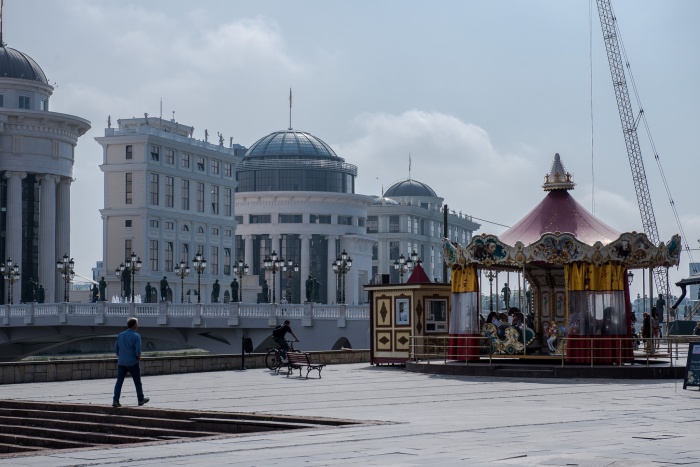
I po. Nowe budynki wybudowane w ramach projektu "Skopje 2014". Zdjęcie: Milo van Kovacevic, 2014. Źródło: Flickr
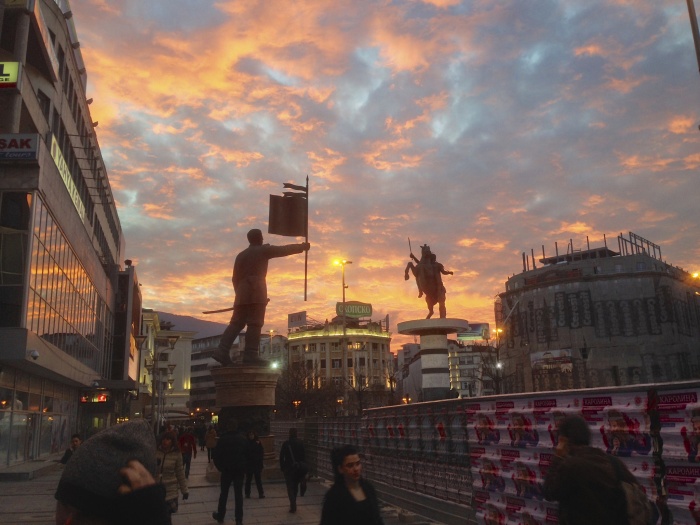
Plac Macedonii w trakcie przebudowy w związku z projektem "Skopje 2014". Zdjęcie: Clay Gilliand, 2014. Źródło: Flickr
Clearly the question of how the government managed to go through with the project if such strong opposition existed against it arises. Though there is a common view of the Macedonians as not being fond of confrontation,14 another scenario was being written in 2009. That was the year when an announcement was made about a church, soon to be built on the main square, which was to be the first construction regarding “Skopje 2014.” A group of architecture students and other activists organized a peaceful protest on 28 March 2009, against the idea of building a church there. The students known as the “First Arche Brigade” formed a square where the church was to be built; holding banners that read “Don’t rape Skopje.” They intended to show how much of the public space would be jeopardized if the building were to be built there. At the same time, a counter-protest was organized, mostly led by supporters of the Orthodox Church. The protest ended violently, with the students being physically attacked. This event is crucial for understanding the jeopardizing of public space in contemporary Skopje. The violent intrusion of the citizens’ right to proclaim their revolt publicly paved the way for a continuous discourse of silencing opinions which oppose the regime.
Artist and activist Filip Jovanovski15 speaks of the possibility of architecture to choreograph our movements in the city. “The shapes of this occupation show a strong link between politics, urban planning, art, and activism. The political apparatus throughout different mechanisms, the most dominant ones of which are art and culture, is maneuvering our bodies and lives,”16 he comments. Concerning the “suffocation” of the public space in Skopje, Filip breaks the argument down on two levels:
The state chokes all openings for the possibility for democratic action. They are literally occupied physically, in the public space and [symbolically] through the institutions. I believe we cannot discuss public space without talking about public institutions.17
He believes that the politics of the Government are changing the physical public space of Skopje according to their ideological program, but at the same time influencing the institutions in a similar manner − by closing them off to alternative ideas. Hence, it is possible to speak of the intrusion of democratic space, through the occupation of physical space.
The effect of the project “Skopje 2014” can be observed on multiple levels. Firstly, the most obvious of them all is the physical modification (reconstruction) of the city center. The city has completely lost its modernist, simplistic look, hidden behind baroque and neo-classic simulacras of facades and sculptures of national heroes. Second is the division of people into supporters and opponents. A high level of disconnect with the locals who disagree with the project was generated, based on the excuse of building a strong national identity. Moreover, the project deepened the already existing gaps in Skopje’s communities according to religious, ethnic, or political basis.18 Thirdly, the urban interventions were introduced at the expense of many green areas and parks in the city center.19 Lastly, the cost of the project financed by public money has risen drastically. The price of Skopje’s remake moved from the announced €80 million at the start, to around €560 million.20 Nowadays, the public space of the city has been absolutely transformed in every aspect. The project has altered the urban reality.
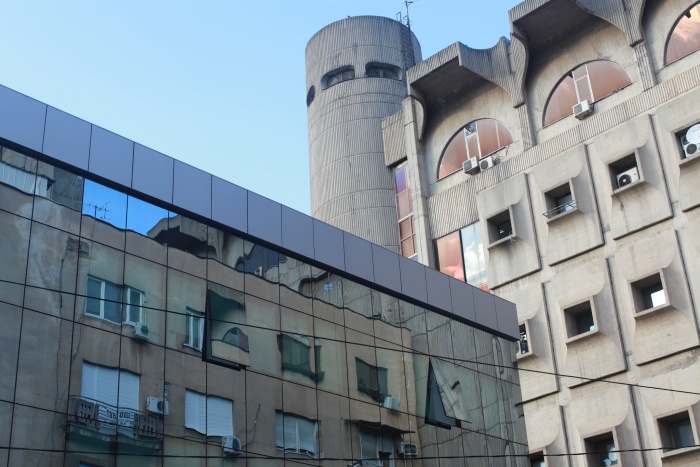
Kontrasty. Współczesna zabudowa i brutalizm obok siebie. Zdjęcie: Jed Horne, 2016. Źródło: Flickr
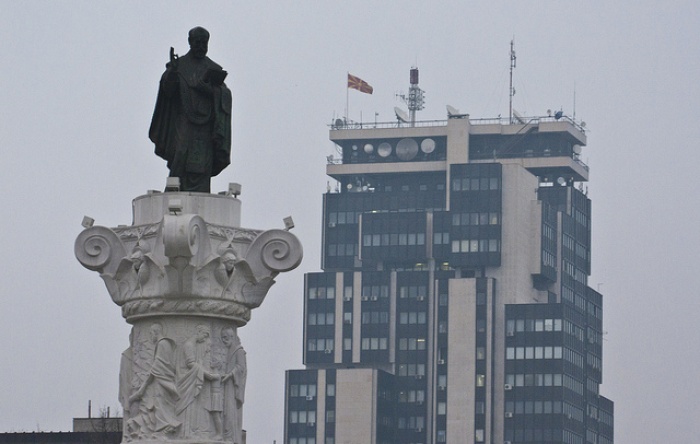
Kontrasty. Jeden z pomników zbudowany w ramach projektu "Skopje 2014" i budynek macedońskiej telewizji w stylu brutalistycznym. Zdjęcie: Ben Scilona, 2014. Źródło: Flickr
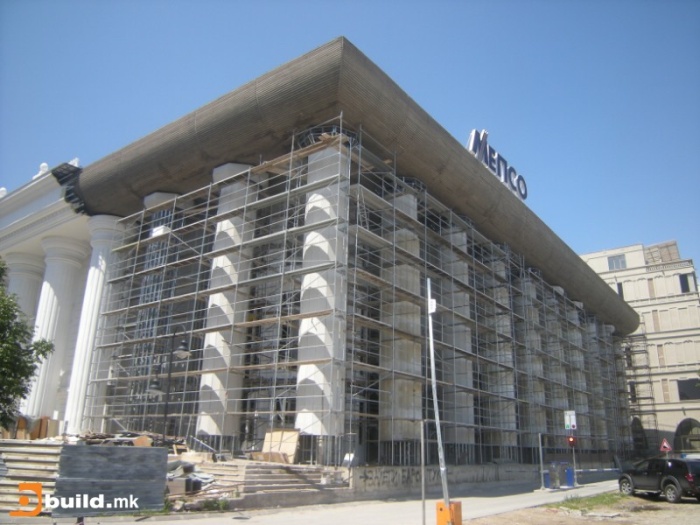
Budynek MEPSO w trakcie przebudowy. Zdjęcie: Bojan Blazevski. Dzięki uprzejmości artysty.
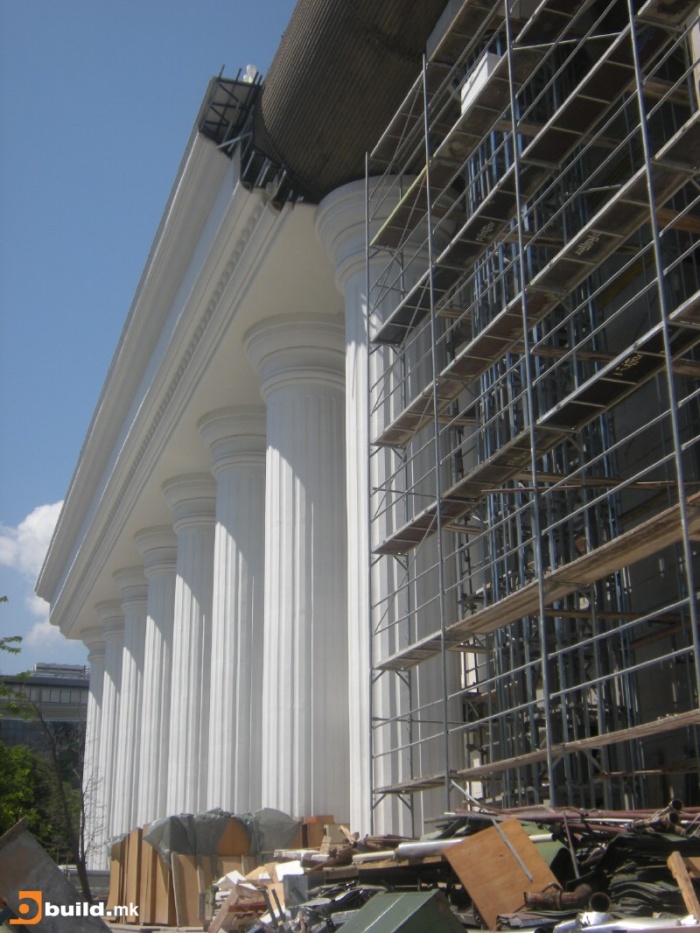
Budynek MEPSO w trakcie przebudowy. Zdjęcie: Bojan Blazevski. Dzięki uprzejmości artysty.
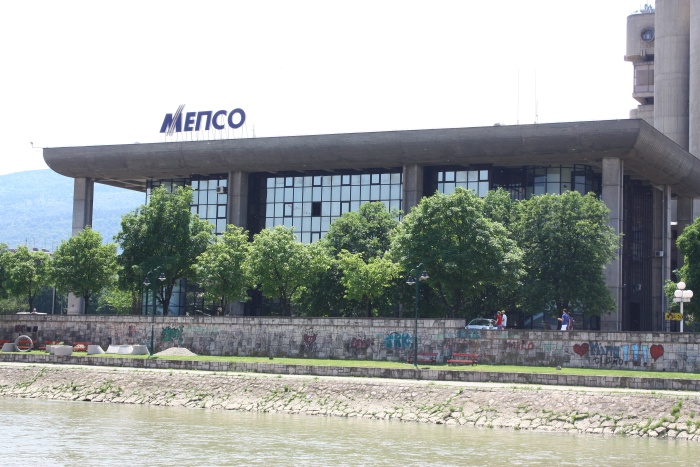
Budynek MEPSO przed przebudową. Zdjęcie: Raso, 2011. Źródło: Wikimedia Commons
2. A New Culture of Urban Resistance
Nonetheless, the intrusion of the public space from the position of power gave birth to a post-effect, also to be faced in the public space of Skopje. Urban mobilization has developed significantly in the city of Skopje in the period after 2010, mainly as a reaction (direct or indirect) to the political situation in the country. The most vital preservation movement in Skopje was an urban initiative against the re-make of modernist buildings into baroque ones. The anti-“Skopje 2014” movement started with “Don’t rape Skopje!” in 2008, but it became more structured with the initiative “I love GTC” aiming at defending the authenticity of the downtown mall built in 1973 by famous architect and professor Zivko Popovski. The initiative was created after it was announced that, as part of the project “Skopje 2014,” the shopping center “GTC” will get a “brand new” look – a baroque one, that is. For many citizens of Skopje, this building is one of the symbols of modern Skopje and the heart of the city, a strong movement against its “baroquisation” was mobilized. The initiator of the movement Danica Cigi Pavlovska, at that time the president of the Association of Architects of Macedonia, explained the value of the building:
What we have as a phenomenon in Skopje is the combination of commercial and social content in one public space, named GTC (City Trade Center). It is not just a mall, a street, a crossroad or a space for cultural events, but all of that together. Also, it has a very distinct aesthetic dimension, normally for the moment in which it was contracted − a sample of the modern architecture of the second half of the 20th century.21
Dejan, also involved in the movement, argues that GTC is perhaps one of the 3 most important buildings in Macedonia. It is not just important as an architectural piece, but also as a public space. This type of building, that can be used by anyone, is hard to find today and that is its value. Due to the symbolic and practical value of this structure for the city, a group of architects and students started campaigning for the preservation of the building. The first event took place in June 2013 in the form of an urban gathering. Professors, artists, and architects spoke of the value of the building, the memories held in its structure and the importance of preserving it as such. Afterwards, all participants held hands and symbolically hugged the building in order to show the importance and worth it has for them. The symbolic hugging of the building was suggested by Danica at one of the meetings. She explains that she wanted to convey an emotional element through the protest. Dejan sees the hugging as a romantic gesture. “It would sound stupid if I say it was feminine, but for sure it was romantic, the holding of hands that is. The event was soft and humanistic.”22 On the other hand, the hugging was also conceptualized as a “human shield” of protection. The initiative “I Love GTC” acquired great public support. Through their methods of action and communication, they managed to unite people around GTC (both physically and allegorically) and create an urban legend out of the building. What can be observed is a certain praise of the socialist past of the city, especially as the direct opposite of “Skopje 2014.” In that sense, the legacy of Kenzo Tange’s project and the GTC building being part of this legacy, is seen as urban, cosmopolitan, and progressive and “Skopje 2014” as kitsch, national, and backwards.23 The battle for GTC happened in the legal space too, since the initiative started campaigning for a local referendum for the protection of the authenticity of GTC. Beyond the hugging, the artistic interventions and Instagram-campaigns, the initiative sought to solve the issue through an institutional path and use the legal framework and democratic capabilities of the country. The call for a local referendum was already a big leap for the initiative, since this was the second local referendum to happen in the history of the country.
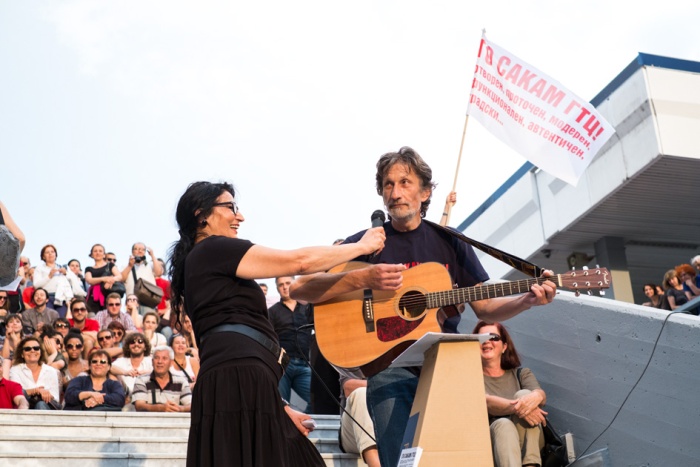
Protest przeciwko przebudowie Miejskiego Centrum Handlowego (GTC). Zdjęcie: Vanco Dzambaski. Dzięki uprzejmości artysty.
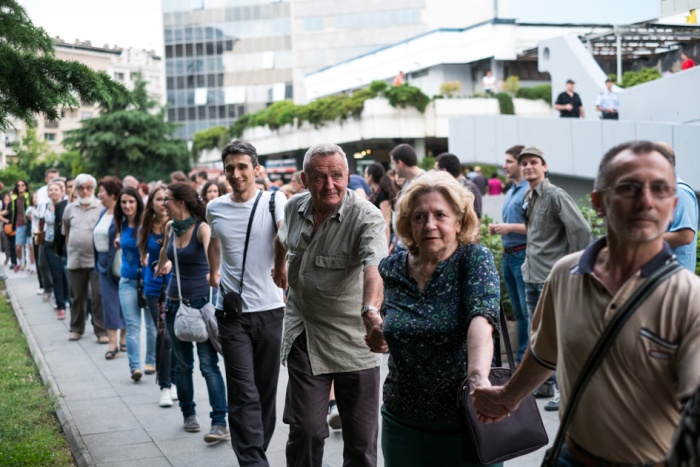
Protest przeciwko przebudowie Miejskiego Centrum Handlowego (GTC). Uczestnicy otoczyli Centrum łapiąc się za ręce. Zdjęcie: Vanco Dzambaski. Dzięki uprzejmości artysty.
The rejection of the project “Skopje 2014” from the urban culture can also be observed through the form of the last large protests in Skopje, called the “Colorful Revolution” which started in spring 2016, with clear political demands against the current establishment.24 The protest can be perceived as a culmination of most of the movements of resistance that have appeared in the country over the last five to seven years. What is peculiar about these protests with respect to urban interventions is that their main method of protest was paint. When the protesting crowd approached Porta Makedonija (Arc Macedonia) in the center of Skopje, splashes of red, blue, and green paint splashed on its white facade. The Arc was also built as part of the “Skopje 2014” as one of the most controversial creations of the project and, as such, it was creatively “attacked” at the protest on the 15th of April. The paint was removed the morning after and the act was labeled as vandalism and destruction of cultural heritage by pro-government media. However, protesters continued in the same manner, arguing that they were beautifying what was constructed with public money and anyhow, due to the undemocratic way in which the project was built, it does not bear any urban or official cultural value. Some protesters claimed that this method of painting would weaken the political efficiency of the movements, whilst others were praising this form of protest, asking for more direct artistic actions that can blend with the protest movement. Simona Spirovska,25 a regular “protest painter,” explains the rationale behind this approach:
Look, to be a victim of the kitsch that they brought these last 10 years (and I don’t mean just Skopje 2014, but all segments of social and communal living), it had to result in resistance that deals with aesthetics. And the aestheticization, or rather re-aestheticization is not key, but the reclaiming of space which essentially should be ours. We are marking the institutions which make shameful decisions at the expense of the citizens.26
In Filip’s view, who was also to be seen at the protest regularly, the coloring was a cathartic and symbolic action. For him, the aesthetic is not in the color, nor in the stain that the color leaves. Rather it is in the moment of throwing it. Moreover, by figuratively attacking the symbols of the establishment, the protests gain visibility and reactions. “The system gets annoyed when the demonstrators leave behiind authentic marks on the symbols of their power,” he concludes.
As an antipode to the project “Skopje 2014,” the level of protest art and other creative actions have risen dramatically. Since the project was executed through the medium of art and culture, many activists from the opposition have been fighting back with similar methods. Hence, the creative forms that the resistance has taken were a reaction to the form of the occupation of public space by the regime. The inability for the opposing opinions to be expressed through an institutional way, through media or in any other public form, created the necessity for the invention of new mechanisms and methods of communication. According to Filip, the only way left was out-of-the-box actions that would reach the public. The creative actions are trying to influence the public space like “a hammer,” in Filip’s words. Thus, artistic activism, by exploring and creating alternative mediums for articulating needs and interests publicly, becomes a political act. In the period after 2010 numerous projects were acting against the establishment in a bottom-up, low-scale manner. Actions such as a pop-up culture and art radio “Radio Free Skopje, a political choir “The Singing Skopians,” defenders of parks “Parkobrani,” the creation of female maps of the city “Intimate Maps of the Female Cities” and other ad hoc actions appeared in the public space, addressing different problematic aspects of the political, cultural, urban, and social slaughter of the society. The antagonistic public space where pluralism is not a prevalent value, can be seen as a reason why most of the urban actions in Skopje happen in the realm of counter-culture and engage art practices. Since being pushed out from the public discourse, these activists have been creating alternative channels to get their message across to the public. Hence, a cause-effect relationship between the policies of the conservative rule in Macedonia and the development of an urban culture of resistance may be suggested. Moreover, due to the fact that “Skopje 2014” was implemented through the means of art and culture generated high level of resistance via those same channels. Therefore, urban movements sought to re-appropriate and re-shape the public space through alternative, bottom-up artistic methods. In this way, the act of leaving their symbols behind in the city has become a political gesture. In that sense, we can speak of art activism as “a tactic” for political action from a marginalized position. This concept was touched upon in the literature on artistic activism:
Without a place of its own, a tactic operates in isolated actions, takes advantage of opportunities and depends on them, reacting immediately. Tactics are characterized by mobility, speed, and smaller goals. De Certeau likens it to poaching: “It must vigilantly make use of the cracks that particular conjunctions open in the surveillance of the proprietary powers…It creates surprises in them…In short, a tactic is the art of the weak.”27
However, since the political crisis of the country was only deepening, these types of alternative, peaceful actions could not have a reverberation that is strong enough. Therefore, the most structured and effective urban mobilization have become large-scale protests which escalated in 2015 and 2016 and resulted in early elections and a new government in 2017. Though it is early to either praise or condemn the newly formed government led by the Social-Democratic party, there has been some steps taken that are already becoming visible regarding the city space. A special body created by the Ministry of Culture involving experts in the field will analyze and assess the different aspects of “Skopje 2014” and give recommendations towards possible scenarios on the future of the project. Though it is said that all building is currently paused, the question of how to deal with all the erected buildings and monuments remains open. Perhaps these new political evolvements are a fresh change for Skopje to start over once again and possibly this time evolving towards a more natural, citizen-friendly, and organic city. On the other hand, the danger that yet another radical, top-down change is just around the corner is felt in the form of urban “schizophrenia” amongst the locals which are not giving the city up and continue to live, work and strive in the city baffled in all of its imposed identities. However, it is exactly these persistent people who provide the needed energy hope and continuity that was sucked out from the city by decades of turbulent political times. At the risk of sounding stupidly optimistic and romantic, I do believe that the city of Skopje can still become the home we are craving for, that was brutally taken away from us, the citizens.

Kolorowa Rewolucja. Łuk triumfalny (Porta Makedonija) został obrzucony kolorową farbą przez protestujących. Zdjęcie: John Crane, 2016. Źródło: Wikimedia Commons.
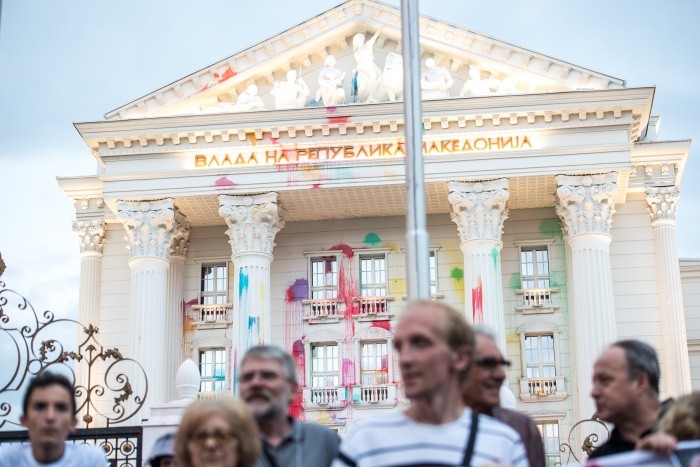
Kolorowa Rewolucja. Rządowy budynek wybudowany w ramach projektu "Skopje 2014" został obrzucony farbą przez protestujących. Zdjęcie: Vanco Dzambaski. Dzięki uprzejmości artysty.
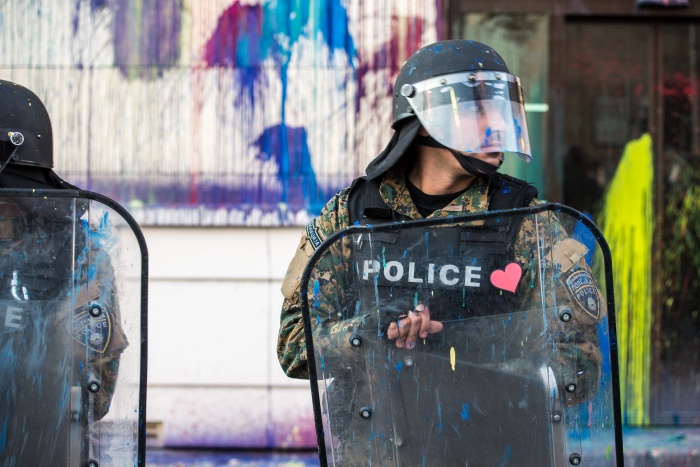
Kolrowa Rewolucja. Policjanci chronią budynki przed protestującymi rzucającymi w nie farbami. Zdjęcie: Vanco Dzambaski. Dzięki uprzejmości artysty.
3. Towards the bigger picture
Since it is difficult to develop criteria for assessing the different accomplishments of urban movements, their emancipatory potential and political influence is something to keep in mind. The importance of urban activism is the potential to influence the citizens into becoming more actively involved in public matters, opening potential horizons for future action space.28 To be able to understand the achievements of the urban movements a deeper way of looking at their actions is needed. Rather than focusing on their immediate results (or the lack of them), we need to grasp their capacity of empowerment, encouragement, and mobilization. For the specific case examined in this essay, the city becomes a crucial braking (or making) point for departure, both as a stage of oppression and liberation. In that respect artist Krzystof Wodiczko speaks of the city as a medium for the “practice” of democracy:29
The city is both the stage and the stake of democracy. Paraphrasing Jacques Derrida, it is possible to say that “the city does not exist.” Like democracy the city is a phantom, “a thing to come” (a venire), a “thing to become”. And this is where our ethical and political responsibility comes in as a continuous, constantly repeated effort (encore un effort) and work on the city.30
Accordingly, in such understanding, the city becomes a platform where citizens are able to create and articulate their specific identities, but even more importantly, to de-articulate/re-articulate the norms of society. Despite the fact that often times the urban movements presented are small-scale and do not deal with political issues directly, they have introduced a concept of citizenship which is related to struggles concerning the most tangible political space, that is the city. In that way, urban mobilizations have affected the concept of active citizenship and participation in the public discourse. Correspondingly as in other cities in the region, the urban movements are advocating for the right to the city whether through symbolic battles, democratic mechanisms or direct political actions − such as protests. Analysis of contemporary urban public mobilization in post-socialist cities can contribute to the debate of public space and what “publicness” means for political action:
The “publicness” of a space is largely measured in terms of its accessibility, inclusiveness, and the freedom of expression possible there. “Publicness” can be threatened by increasing control […], commercialization, and fear. These terms can be easily applied to socialist, post-socialist, and western capitalist societies. A popular way of discussing public spaces in western capitalist cities is to address the limitations to access resulting from growing social inequalities and attempts by well-off publics to “segregate” themselves from undesirables. Socialist cities were free from these negative effects of capitalism. Public space, however, was controlled and policed by the state to a larger degree than was the case in Europe and the US. Post-socialist societies now face both the new challenges of capitalist inequalities and the legacies of their totalitarian and authoritarian pasts.31
It is difficult to compare and create common traits for post-socialist cities which indeed experienced rather different development, the most important split being “between countries that experienced gradual consolidation of democratic institutions and practices, and countries that experienced the retrenchment of liberties and freedoms and restoration of authoritarian systems.” The different political development in the counties concerned are of importance when speaking of urban mobilization; since it directly influences the way the citizens are able to engage. What they have in common however, is that by using the city space as a platform for social change, they negotiate the meaning of the urban space, raise the level of social capital, create networks based on solidarity and develop a higher level of citizens’ consciousness and proactiveness. What is more, local mobilizations in post-socialist space challenge the stereotype of a “weak” civil society. The fight for the preservation of a building, a square or a tree, goes beyond the object that stimulated the mobilization. Rather it is the rights of a group of citizens that identify with the urban narrative that has been jeopardized.
In that sense, in the case of Skopje it is possible to speak of a culturocide happening as a side effect of the government policy.32 The obliteration of the urban heritage is an attempt to erase memories, meanings, and values away from the public space of the city and citizens which identify with it. In order to confront this threat, most of the activists found their specific battle to be also a part of the anti-government protests. Lastly, the most relevant gain for the community due to the rise of urban social movements is the empowerment of citizens. In the post-socialist scenery, where social capital is relatively low and public engagement is not common, the rise of grassroots activism serves as a platform for “political becoming.”33 As implied by this essay, the oppressive political climate in the country did play a major role in strengthening low-level, symbolic, grassroots activism, as the only possibility for the expression of public resistance. Moreover, the implementation of the project “Skopje 2014,” a particular project which is hard to compare to other urban interventions in the region, also contributed greatly to the rise of civic engagement in Skopje. This occupation of public discourse though the fields of art and culture, generated resistance in these same fields. The rise of artistic activism in that process, when other civic instruments are inaccessible, leads to the conclusion that art, in times of political crisis, can create horizons for further political action. The experiences of activism, collaboration, victories, and losses acquire a new sense of the place of the citizen in relation to the system, where he/she becomes an agent of change.34 In that sense, public space provides an arena for citizens to step out of the private space and step into the public one, to become visible, outspoken and, eventually, political.
BIO
Kalia Dimitrova, born in 1991, is from Skopje, Macedonia. She currently works in the NGO sector in Skopje, focusing on projects in the field of youth participation, creative engagement and socially engaged art. She is particularly interested in feminism and alternative cultural practices.
She graduated from the University Ss. Cyril and Metodius in Skopje majoring in political science. Her master’s degree in the field of cultural studies brought her to the Netherlands, Poland, and USA where she lived and studied. Her master’s thesis “Reappropriating public space: The case of urban social movements in the city of Skopje” focused on artistic activism practices in the city of Skopje in a time of political crisis. She has been writing poetry as long as she remembers and published some poetry during her stay in the USA and became involved in poetry readings, events, and collaborations in Skopje, Macedonia. Similar to her academic and professional interests, her poetry centers around the city of Skopje and/or the very idea of the city as a micro-space in which people have learned to function together. She is inspired by the buildings that witness movements, the social injustice, the asphalt and the trees, the memories of the streets, the love in the city and for the city, the dance floor, politics, the struggles of women and their intimate stories somewhere among all others.
[1] Zoran Popovski, "Public Space: Participatory Art Project" Zoran Popovski artBlog (blog) accessed 11 July 2016, http://www.poposki.info/2009/07/public-space-participatory-art-project.html.
[2] Nikos Chausidisin, Проектот Скопје 2014 : Скици За Едно Наредно Истражување (Skopje: Nikos Čausidis, 2013).
[3] Jakim T. Petrovski, “Damaging Effects of July 26, 1963 Skopje Earthquake” (Institute of Earthquake Engineering and Engineering Seismology, University “Cyril and Methodius,” Skopje, 2004).
[4] Nikos Chausidisin Проектот Скопје 2014: Скици За Едно Наредно Истражување.
[5] Jacobsson, "The Development of Urban Grassroots Movements in Central and Eastern Europe".
[6] Nita Çavolli, “A City Surprised- An Analysis of Visual Content and Public Debate, Skopje 2014” (MA Thesis, New York University Skopje, Faculty of Communication and Media Studies, 2012).
[7] Vilić, Силувајте Го Скопје!(Кн. 2) [Rape Skopje! V 2 ].
[8] Ibid.
[9] Ibid.,33.
[10] Chausidisin Проектот Скопје 2014 : Скици За Едно Наредно Истражување.
[11] Vilić, Силувајте Го Скопје!(Кн. 2) [Rape Skopje! V 2 ].
[12] Ibid.,19
[13] hereafter Kristina
[14] Many Macedonian proverbs celebrate silence and respect of authority rather than opposition and confrontation. An example is the proverb “a hand bent down will not be cut by the saber”
[15] Hereafter Filip
[16] Filip Jovanovski, interviewed by author, Skopje, April 17, 2016, translated transcript.
[17] Filip Jovanovski, interviewed by author.
[18] Bertan Selim, “Skopje 2014 - A Recipe for Urban Disintegration," Balkan Insight, accessed 30 May 2016, http://www.balkaninsight.com/en/article/skopje-2-aa4-a-recipe-for-urban-disintegration.
[19] Ivana Dragsic, “Skopje Facelift: Megalomanic Project Devours the City,” accessed May 30, 2016, https://ba.boell.org/sites/default/files/uploads/2016/01/how_skopje_2014_ate_the_skopje_commons_extended.pdf.
[20] “True Cost of ‘Skopje 2014’ Revealed” accessed 30 May 2016, http://www.balkaninsight.com/en/article/true-cost-of-skopje-2014-revealed.
[21] Danica Pavlovska, interviewed by author, Skopje, April, 2016, translated transcript.
[22] Dejan Ivanovski, interviewed by author. Skopje, April, 2016, translated transcript.
[23] Ibid.
[24] “About the Protests | Протести Македонија 2015/2016| Protests Macedonia 2015/2016,” accessed 22 June, 2016, http://protestiram.info/?page_id=40.
[25] hereafter Simona
[26] Simona Spirovska, online interview with author, 12 July 2016.
[27] Popovski, “Spaces of Democracy: Art, Politics, and Artivism in the Post-Socialist City”, 717.
[28] Jacobsson,"The Development of Urban Grassroots Movements in Central and Eastern Europe".
[29] Krzysztof Wodiczko, “The City, Democracy, and Artistic Practice”, Signum Foundation, Poznań Academy of Fine Arts, Poznań Academy of Fine Arts, 12 September 2007.
[30] Ibid., 2.
[31] 234.
[32] Vaseva and Jovanovski, 111 Тези За ГТЦ.
[33] Jacobsson, Urban Grassroots Movements in Central and Eastern Europe.
[34] Boris Groys, “On Art Activism.”



